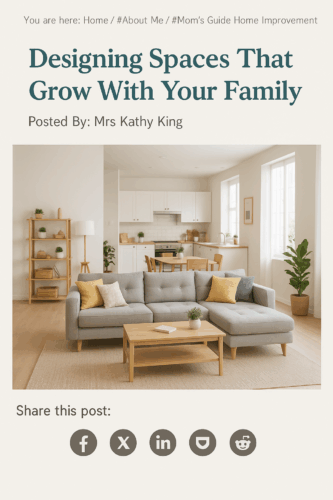
Finding ways to make your home evolve as your family grows can feel like a daunting task. Still, creating a space that adapts over time can save you stress and money in the long run, and the key to success lies in thoughtful design. Read through my practical and creative ideas for designing spaces that grow with your family and focusing on comfort and functionality for every stage of life.
Creating Flexible Living Areas
The heart of any home is its shared living spaces. A living room, for instance, can serve multiple purposes if designed with flexibility in mind. For example, sectional sofas can adapt to hosting movie nights with your immediate family and accommodating guests for lively holiday get-togethers.
Consider creating a family-friendly bathroom that is fun yet functional for all ages! When selecting furniture and décor, consider long-term benefits and multifunctionality. These adaptable and versatile spaces are crucial for striking a balance between family life and design aesthetics.
Turning Bedrooms Into Transformative Spaces
When families expand, bedrooms often need to evolve. Creating a personalized nursery is a great example of how a simple design approach can adapt to dynamic needs. Start with child-friendly furniture, such as a convertible crib that can transition into a toddler bed as your baby grows. Once your kid becomes a teenager, they can really claim the room by decorating it however they want! A thoughtfully designed bedroom should feel like a sanctuary for each family member, regardless of their age.
Creating Dynamic Storage Solutions
Designing built-in wall units or under-bed drawers can transform unused areas into practical and functional storage spaces. Over the years, toy bins may give way to hobby supplies or work materials for teenagers, and you can even design entryways to evolve, shifting from hosting shoe racks to larger storage systems. Keep in mind that storage is not just about functionality; it’s also about maintaining a visually appealing and organized home.
Maintaining a Connection Through Communal Spaces
Whether you go with an open-plan dining area or a cozy reading corner, shared spaces are critical for fostering family connections. Building a kitchen-dining room combo with an expandable table, for instance, provides ample space for family gatherings, special dinners, or festive celebrations. Designing communal areas with adaptability in mind supports inclusivity, resulting in young children feeling as comfortable and welcomed as grandparents who come to visit your home.
Looking Ahead
It’s exciting to think about how thoughtful design can adapt to life’s changes. Every element, from a personalized nursery to dynamic shared spaces, shapes a home that works for everyone. The beauty of designing spaces that grow with your family lies in its ability to blend function with style, ensuring that your home evolves as seamlessly as your family does. Take the first step toward designing a space that feels like home at every stage of life!
Leave a Reply